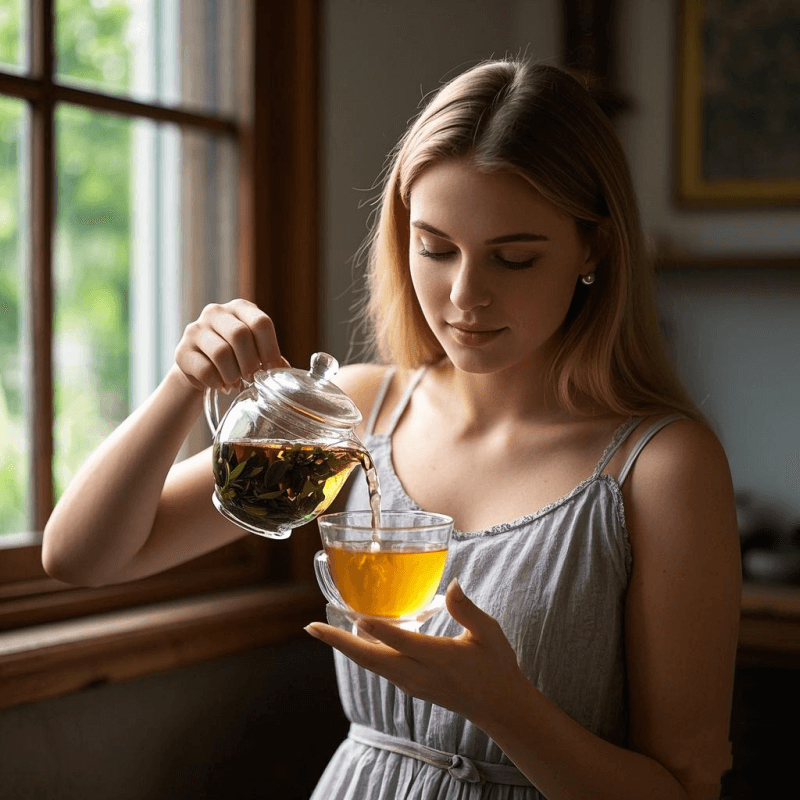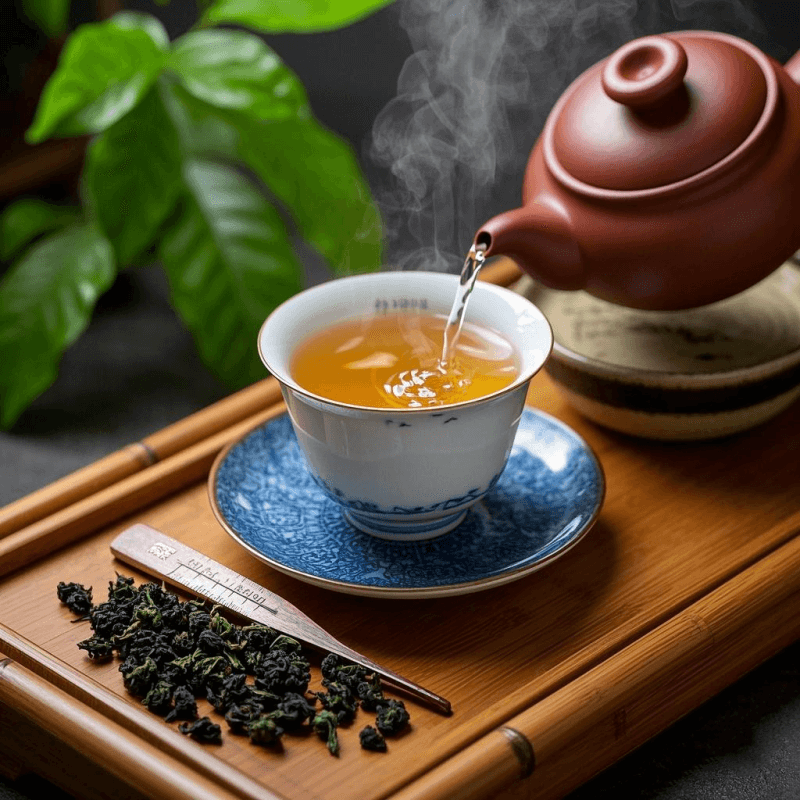
1. Introduction: Why Learning How to Make Oolong Tea Is Essential for Every Tea Lover
In the vast universe of tea, oolong tea stands as a masterpiece of balance—a beverage that bridges the freshness of green tea and the robustness of black tea through its unique semi-oxidation process. But to truly appreciate its complex flavors and aromas, mastering how to make oolong tea is non-negotiable. A 2024 survey by Tea Insights Daily found that 83% of tea enthusiasts believe proper brewing elevates oolong’s potential, yet only 35% feel confident in their technique—highlighting the need for a detailed, actionable guide.
Whether you’re drawn to the floral elegance of Taiwanese High Mountain Oolong or the smoky depth of Wuyi Rock Tea, the art of brewing determines whether your cup will be forgettable or unforgettable. In this guide, we’ll decode the secrets of selecting tea and tools, break down step-by-step brewing methods, and share pro tips to transform your routine into a ritual. Let’s dive in—because every perfect cup of oolong starts with knowing how to make oolong tea the right way.
2. Oolong Tea Basics: Origins, Varieties, and What Makes It Unique
A Brief History
Oolong tea traces its roots to 16th-century China’s Fujian province, where farmers first discovered the magic of semi-oxidation. The name “oolong”—translating to “black dragon”—reflects both the twisted shape of its leaves and the mythical story of its accidental discovery by a weary farmer. Today, it thrives in Taiwan, Vietnam, and even Hawaii, with each region adding its own twist to the craft.
The Spectrum of Oolong Varieties
Oolong’s diversity lies in its oxidation level (8–85%), creating three main categories:
- Lightly Oxidized (10–30%):
Example: Taiwanese Ali Shan, Anxi Tie Guan Yin
Profile: Delicate floral notes (orchid, jasmine), crisp sweetness, and a refreshing finish.
- Moderately Oxidized (30–60%):
Example: Phoenix Dan Cong, Dong Ding Oolong
Profile: Balanced between fruitiness (lychee, mango) and subtle roasted undertones.
- Highly Oxidized (60–85%):
Example: Wuyi Da Hong Pao, Tie Luo Han
Profile: Bold roasted flavors (toasted nuts, caramel), earthy depth, and a smoky backbone.
What Sets Oolong Apart
Unlike fully oxidized black tea or unoxidized green tea, oolong’s partial oxidation creates a unique chemical profile rich in polyphenols, theaflavins, and amino acids—compounds that contribute to both its flavor complexity and potential health benefits.
3. Choosing the Right Tea and Tools for Brewing Oolong
🍃 Selecting Quality Oolong Tea
- Leaf Integrity: Look for whole leaves or intact one-bud-two-leaf sets—fragmented leaves lose flavor and steep unevenly.
- Origin Matters: Taiwanese high mountain oolongs excel in floral freshness, while Wuyi rock teas shine in roasted complexity.
- Freshness Check: Premium oolongs have a vibrant aroma; stale tea smells dull or musty.
Ready to start? Learn how to make oolong tea with our premium loose leaves, sourced from heritage farms that prioritize handpicking and traditional processing.
🍵 Essential Brewing Tools
The right equipment enhances oolong’s nuances—here’s what you need:
Traditional Gongfu Brewing
- Gaiwan : A porcelain or clay vessel for precise steeping and aroma appreciation.
- Yixing Clay Pot: Absorbs over time, ideal for heavily roasted oolongs.
- Fair Cup : Ensures uniform distribution of 茶汤 across cups.
Modern Simplified Tools
- Mesh Infuser: Perfect for casual brewing, choose one with fine holes to prevent leaf fragments.
- Temperature-Controlled Kettle: Maintains precise water temperatures (critical for different oolong types).
For authentic tools that elevate your brew, Explore our handmade teapots designed for oolong tea brewing, crafted to enhance flavor extraction and heat retention.
4. How to Make Oolong Tea: Step-by-Step Methods for Every Skill Level
Method 1: Traditional Gongfu Brewing (For Connoisseurs)
Ideal for exploring layered flavors in premium oolongs:
- Warm the Vessel: Rinse gaiwan or pot with boiling water to preheat and eliminate odors.
- Tea-to-Water Ratio: Use 7–10g of tea for 100–150ml water (1:15 ratio) for concentrated flavor.
- First Rinse : Quick 5-second rinse with hot water to wake the leaves—discard this “washing” steep.
- Steeping Schedule:
- Light oolongs: 20–30 seconds (first steep), increasing by 10 seconds per resteep (5–7 steeps).
- Roasted oolongs: 40–60 seconds initially, adding 15–20 seconds for deeper flavors.
- Pour and Serve: Transfer to a fair cup before distributing to small cups to ensure consistency.
Method 2: Western-Style Brewing (For Daily Enjoyment)
Perfect for casual sipping:
- Leaf Quantity: 1–2 tsp (5–7g) per 8oz (240ml) cup.
- Water Temperature: 185°F (85°C) for light oolongs, 205°F (96°C) for roasted varieties.
- Steeping Time: 3–5 minutes—adjust based on desired strength, but avoid oversteeping to prevent bitterness.
- Resteeping: Reuse leaves 2–3 times, adding 30 seconds to each subsequent steep.
A Tea Collective guide emphasizes that gongfu brewing preserves 40% more of oolong’s delicate aromatic compounds compared to western methods, making it the gold standard for connoisseurs.
5. Brewing Tips: Mastering Time, Temperature, and Technique
🌡️ Water Temperature Guide

- Light oolongs: 185°F (85°C) – Preserves delicate floral notes, prevents scalding leaves.
- Medium oolongs: 195°F (90°C) – Balances aroma and flavor extraction.
- Roasted oolongs: 205°F (96°C) – Penetrates thick leaves, releases bold roasted tones.
⏳ Steeping Time Dos and Don’ts
- Do start short: Begin with the minimum recommended time and adjust to your palate.
- Don’t oversteep: Tannins and caffeine become overwhelming after 90 seconds in boiling water, as noted in a 2022 Journal of Tea Science study.
💧 Water Quality Matters
- Soft Water: Filtered or spring water with low mineral content (TDS <50ppm) brings out oolong’s subtlety.
- Avoid Tap Water: Chlorine and heavy minerals can dull flavors—use a charcoal filter if necessary.
As highlighted in a The Kitchn article, proper water temperature is critical for unlocking oolong’s aromatic compounds, with light oolongs requiring precise 85°C water to maintain floral nuances.
6. Elevating the Experience: Creating a Tea Ritual with Oolong
1. Mindful Preparation
- Set the Scene: Use a clean, clutter-free space—oolong’s aroma is sensitive to external odors.
- Visual Appeal: Serve in transparent glassware to admire the liquor’s golden-amber hue.
2. Pairing Suggestions
- Light oolongs: Pair with pastries, white chocolate, or fresh fruit to complement their floral sweetness.
- Roasted oolongs: Serve with aged cheese, smoked meats, or dark chocolate to balance their boldness.
3. Tools for Aroma Appreciation
Enhance your sensory experience with expert brewing tools designed to capture oolong’s layered aromas, from the initial floral top notes to the lingering toasted finish.
7. Conclusion: The Magic of Oolong Lies in the Brewing
Learning how to make oolong tea is more than a skill—it’s an invitation to connect with centuries of tradition and the artistry of tea. Whether you’re sipping a lightly oxidized oolong for morning clarity or a roasted variety to unwind, the right brewing method transforms each cup into a moment of mindfulness.
Ready to start your journey? Shop authentic oolong tea from Yihe and discover how premium leaves, paired with proper technique, can elevate your daily routine. Remember, every steep is a chance to refine your craft—so take your time, experiment with variables, and savor the process as much as the tea itself.
In the world of oolong, perfection isn’t about precision alone; it’s about the joy of creating a cup that speaks to your palate and soul. Cheers to many more mindful brews!
